Shifting pet spay/neuter into high gear
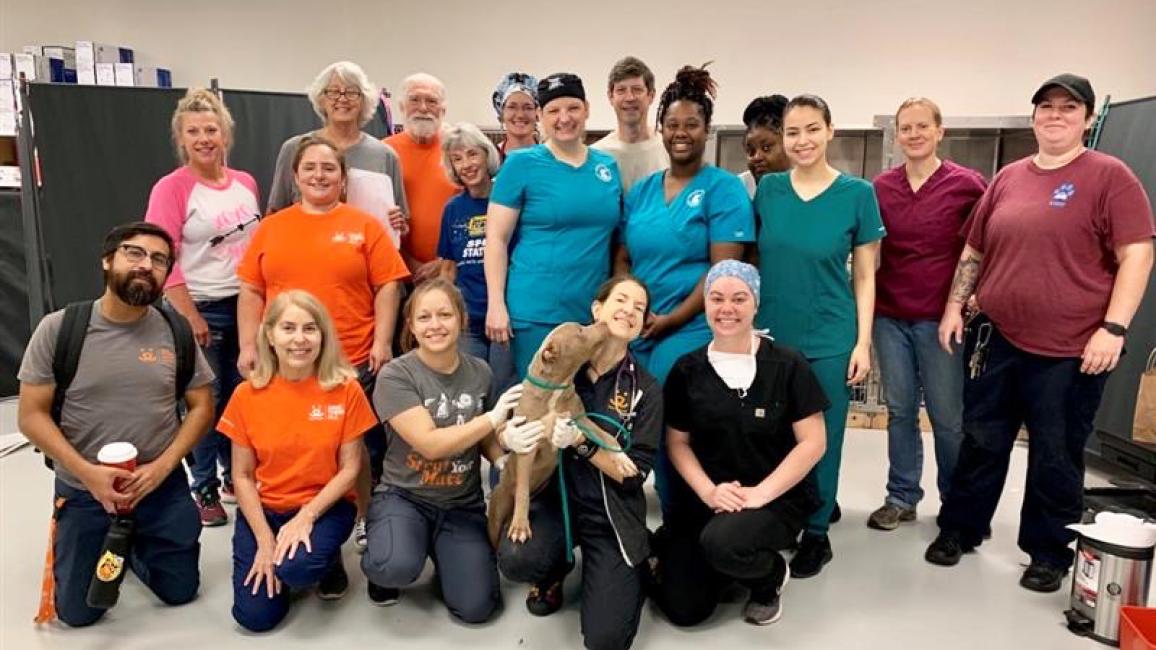
If you have pets, you’re likely familiar with how difficult it is to get a vet appointment these days. Animal shelters and rescue organizations across the country are struggling with the same challenges, and it’s impacting the ability to keep up with spay/neuter surgeries. Preventing unplanned or unwanted litters of puppies and kittens is an important part of making the country no-kill by 2025. That’s why we’re training veterinary staff at other organizations on how to help more dogs and cats through spay/neuter.
The training workshops teach vets and support staff how to do high-quality, high-volume spay/neuter (HQHVSN). According to Best Friends medical director Dr. Erin Katribe, vets who are skilled at HQHVSN can cruise through 50 or more surgeries in a day with the streamlined, efficient techniques distinctive to this approach. That’s compared to roughly 20 surgeries a day in most shelters for vets who don’t practice this approach.

Free training for shelter veterinary staff
This past April, Best Friends launched a shelter medicine outreach program where Erin and other vets skilled at HQHVSN provide 20 hours of free hands-on training to vets and veterinary technicians.
These training workshops aren’t just helpful to veterinary staff who join them. They also allow the Best Friends team to help our partners in the area by spaying and neutering their pets. You need a lot of available patients to run a workshop that trains vets to spay and neuter up to 50 pets in a single day.
And that’s only the beginning. Vets and support staff who go through the training will take those skills home and put them to use in their own shelter medicine programs.
[New veterinary resources for pets in Navajo Nation]
“The general response from industry folks is that this is much needed, and vets are eager to participate,” says Erin, who oversees the program. “I see posts all the time on social media about the need for more training among shelter medical staff.”
Dr. Lauren M. Kloer, an independent veterinary consultant and relief veterinarian who was the instructor for the October training in Houston, agrees.
“Across the country, shelters and spay/neuter clinics are not just understaffed; some have no veterinary staff,” Lauren says. “These shelters and clinics are desperate for veterinarians and veterinary technicians proficient in providing HQHVSN services.”
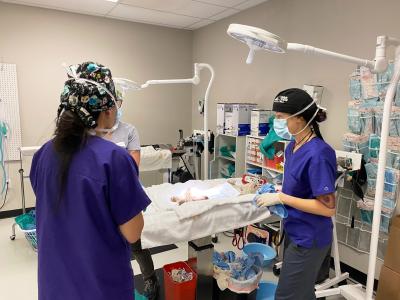
Building skills, preventing burnout
Essentially, the workshops are designed to train veterinarians who are new to shelter medicine or to high-volume spay/neuter. The goal is to increase the capacity of those already working in shelter programs or high-volume surgery programs, so they can do more surgeries with the same number of veterinarians.
“There is also a technician component to this equation,” Erin says. “It’s not just speed; it’s the capacity of the entire system.”
At Best Friends in Houston, where several of the trainings have taken place, volunteers assist in various roles, including anesthetic recovery monitoring, surgical instrument cleaning and sterilization, data entry, and clinic check-in and discharge. “Their contribution doesn’t just help the animals being served on workshop days, but all of the dogs and cats that workshop participants will provide surgery for in the future,” Erin says. “Our volunteers are truly rock stars, and we couldn't do this work without them.”
[Embed program helps cats and people who love them in North Carolina]
Safety for pets is also important. (That’s part of the “high-quality” label in high-quality, high-volume spay/neuter.) In fact, data for high-volume clinics shows the complication rate of both surgery and anesthesia is the same or less than it is in general private practices or even specialty hospitals.
The primary goal of the workshops is to build professional skills. But Erin is careful to talk about HQHVSN in a way that underscores not only an increase in the number of surgeries, but also a change in the way veterinary teams work.
“The goal is to be able to care for more pets — but also do it in a way that is sustainable and humane for our staff at all levels, so we avoid burnout,” she says. “Teams can get turned off by the need to do more, more, more when it’s not accompanied by a plan and practical strategies to make that happen, outside of just putting in more hours and becoming overworked.
“That’s particularly true in the current climate of shelters at or over capacity than pre-pandemic levels,” she continues. “Those realities are just adding to the stress level of everyone in the shelter, vet staff included.”
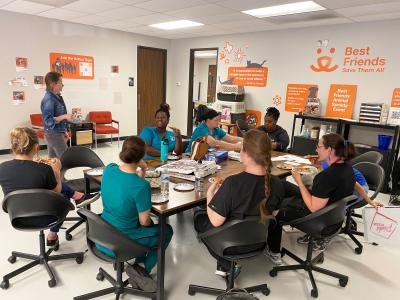
Stepping up to support shelter needs
Veterinary staff from around the country are taking advantage of the opportunity to learn. “There are few opportunities in the country for graduate veterinary professionals to receive this specific hands-on training,” Lauren says. “There is a thirst for HQHVSN knowledge in the veterinary community, and I'm so grateful that Best Friends has created a program which offers this desired hands-on training.”
“I was looking forward to learning tips and tricks in my spays and neuters for faster and higher-quality surgeries,” says Dr. Itzel Vizcarra, a staff veterinarian with Riverside County Department of Animal Services. She participated in a workshop Best Friends held at her home shelter this summer. “Having this training so early in my career has been extremely beneficial, and my surgery time has been cut in half,” she says. “It was very helpful being able to discuss different aspects about shelter medicine with Dr. Erin and so reassuring to know that people like her are helping shelters.”
The vet techs who have attended the training thus far also found it to be hugely helpful to their daily work.
“I was expecting it to be a learning class, not hands-on, but boy was I wrong!” says Jemisha Wright, a veterinary assistant from Oklahoma City Animal Welfare “When we arrived, Dr. Erin threw us right in as if we had been working with her for years. I come from a huge shelter that doesn’t have a lot of medications, fancy machines and barely any staff, but now I am able to show my team the new things I have learned from the training that make things so much easier.”
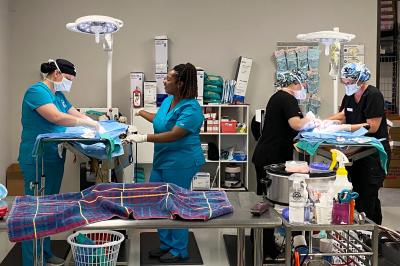
A numbers game to save dogs and cats
From Erin’s perspective, the lifesaving progress made in recent years can in part be attributed to more dogs and cats being spayed or neutered. By her calculations, if vets can halve their surgery time on a cat spay, they would be able to do 25% more surgeries on cats per day, on average. Just going from 30 to 40 cats a day means potentially 2,000 more cats would be spayed or neutered per year in a single program.
“We have local shelters where the gap to that 90% save rate is just cats,” she says. “They will reach that no-kill benchmark if they can save the lives of roughly 1,500 more cats per year — because that’s how many cats are currently losing their lives there. One vet going through the program could tackle this gap.”
When you look at it that way, it’s clear the goal is within reach.
“We must keep spaying and neutering animals at a rapid pace because we won’t reach no-kill by 2025 without it,” Erin says. “One of the questions I love to ask people in this field — and it's a question our CEO Julie Castle asks a lot of people too — is ‘What keeps you up at night when you think about the 2025 goal?’
“Honestly, my answer is the veterinary shortage,” she continues. “It’s not having enough spay/neuter capacity, not having enough medical capacity and knowing that there are solutions for efficiency and capacity at individual shelters. Best Friends can help with that, and these workshops are just the first step in doing so.”
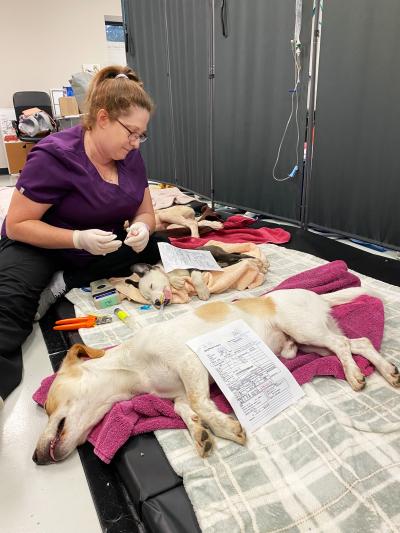
Help pets where you live
Whether you foster, adopt or volunteer, there are many ways to help pets in your community.
Read more
Planned PEThood of Georgia innovates to help rural shelters